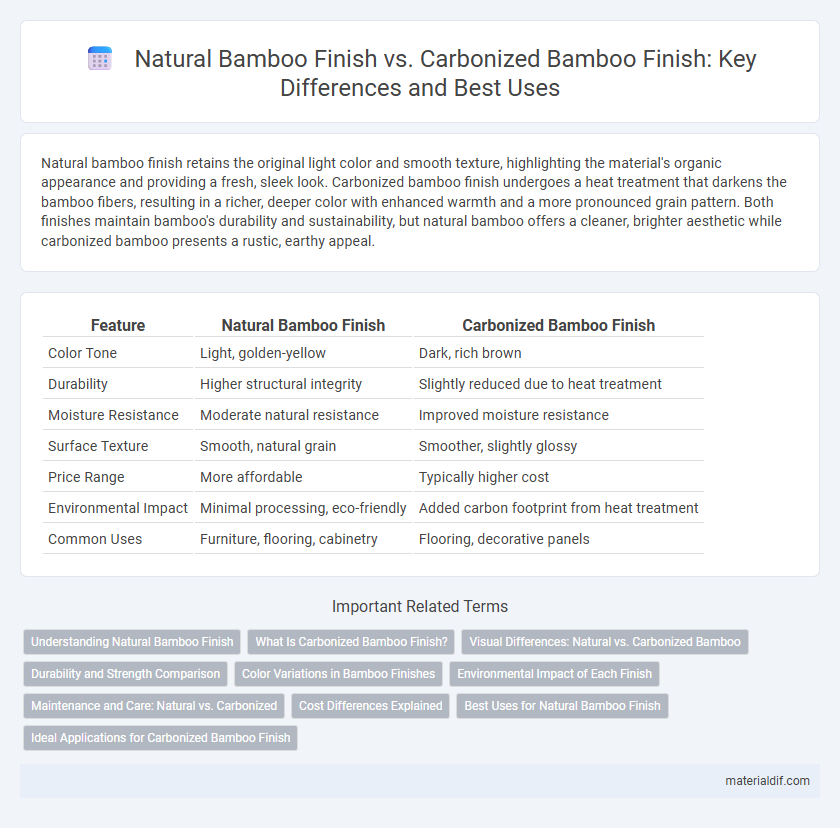Natural bamboo finish retains the original light color and smooth texture, highlighting the material's organic appearance and providing a fresh, sleek look. Carbonized bamboo finish undergoes a heat treatment that darkens the bamboo fibers, resulting in a richer, deeper color with enhanced warmth and a more pronounced grain pattern. Both finishes maintain bamboo's durability and sustainability, but natural bamboo offers a cleaner, brighter aesthetic while carbonized bamboo presents a rustic, earthy appeal.
Table of Comparison
| Feature | Natural Bamboo Finish | Carbonized Bamboo Finish |
|---|---|---|
| Color Tone | Light, golden-yellow | Dark, rich brown |
| Durability | Higher structural integrity | Slightly reduced due to heat treatment |
| Moisture Resistance | Moderate natural resistance | Improved moisture resistance |
| Surface Texture | Smooth, natural grain | Smoother, slightly glossy |
| Price Range | More affordable | Typically higher cost |
| Environmental Impact | Minimal processing, eco-friendly | Added carbon footprint from heat treatment |
| Common Uses | Furniture, flooring, cabinetry | Flooring, decorative panels |
Understanding Natural Bamboo Finish
Natural bamboo finish preserves the material's original light golden-yellow hue with subtle green undertones, highlighting its organic texture and strength. This finish involves minimal processing, maintaining bamboo's natural moisture content and hardness, which contributes to its durability and resistance to wear. Choosing natural bamboo finish enhances indoor air quality by avoiding chemical treatments common in carbonized finishes, making it an eco-friendly and sustainable option for flooring and furniture.
What Is Carbonized Bamboo Finish?
Carbonized bamboo finish refers to a treatment process where bamboo is exposed to high heat and pressure, resulting in a darker, richer color compared to its natural, light tone. This heat treatment not only enhances the bamboo's aesthetic appeal by creating a warm, caramelized look but also slightly softens the material, affecting its hardness and durability. Unlike the natural bamboo finish, which preserves the bamboo's original pale hue and retains its maximum strength, carbonized bamboo offers a more rustic and elegant appearance ideal for interior design applications.
Visual Differences: Natural vs. Carbonized Bamboo
Natural bamboo finish showcases a light, creamy color with subtle variations and a smooth texture, highlighting the organic grain patterns unique to each stalk. Carbonized bamboo finish undergoes heat treatment that darkens the bamboo to a rich, warm brown tone with enhanced caramel hues, creating a more uniform and polished appearance. The visual contrast between the two finishes lies in their color depth and warmth, with natural bamboo offering a brighter, more raw aesthetic and carbonized bamboo providing a deeper, more refined look.
Durability and Strength Comparison
Natural bamboo finish retains the material's original hardness, making it more durable and resistant to wear over time compared to carbonized bamboo. Carbonized bamboo undergoes heat treatment that softens the fibers, resulting in a darker color but slightly reduced strength and increased susceptibility to dents and scratches. For applications requiring long-lasting performance and structural integrity, natural bamboo finish offers superior durability and rigidity.
Color Variations in Bamboo Finishes
Natural bamboo finish showcases the bamboo's light, creamy tones with subtle greenish hues, preserving its organic and fresh appearance. Carbonized bamboo finish undergoes heat treatment, resulting in a richer, darker amber or caramel color with warmer tones that enhance the grain patterns. Color variations in bamboo finishes significantly impact aesthetics, with natural finishes offering brightness and carbonized finishes providing depth and warmth.
Environmental Impact of Each Finish
Natural bamboo finish retains the raw material's organic properties, avoiding chemical treatments and minimizing environmental pollution during production. Carbonized bamboo finish involves heat treatment that alters the bamboo's color and durability but consumes more energy and may release volatile organic compounds (VOCs). Choosing natural finish reduces carbon footprint and supports sustainable manufacturing, while carbonized finish requires careful management to mitigate increased environmental impact.
Maintenance and Care: Natural vs. Carbonized
Natural bamboo finish requires minimal maintenance, retaining its original light color and resisting moisture with regular sealing and gentle cleaning. Carbonized bamboo finish, darkened through controlled heat treatment, demands more frequent resealing to protect against color fading and increased susceptibility to scratches. Both finishes benefit from avoiding excessive water exposure and using soft cloths for cleaning to prolong durability and aesthetic appeal.
Cost Differences Explained
Natural bamboo finish typically costs more due to its minimal processing, preserving the bamboo's original color and texture, which appeals to premium markets. Carbonized bamboo finish undergoes heat treatment to darken the material, reducing production expenses and offering a more budget-friendly option. The cost difference mainly stems from the additional labor and energy required in carbonization, making natural finish bamboo about 10-20% more expensive on average.
Best Uses for Natural Bamboo Finish
Natural bamboo finish retains the original light color and subtle grain patterns, making it ideal for contemporary furniture, flooring, and cabinetry where a clean, modern aesthetic is desired. It offers superior durability and resistance to scratches and dents, which suits high-traffic areas and functional spaces like kitchens and offices. This finish is also preferred for environmentally conscious projects due to its minimal processing, preserving the bamboo's natural strength and sustainability.
Ideal Applications for Carbonized Bamboo Finish
Carbonized bamboo finish, achieved through controlled heat treatment, enhances the material's durability and introduces a rich, amber tone ideal for interior design projects requiring warm aesthetics. This finish is perfect for flooring, cabinetry, and furniture in residential and commercial spaces where moderate moisture resistance and a sophisticated look are essential. Its enhanced color stability and smoother texture make carbonized bamboo finish suitable for decorative wall panels and upscale retail environments.
natural bamboo finish vs carbonized bamboo finish Infographic

 materialdif.com
materialdif.com